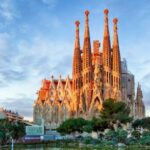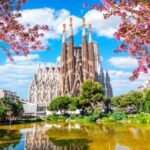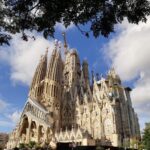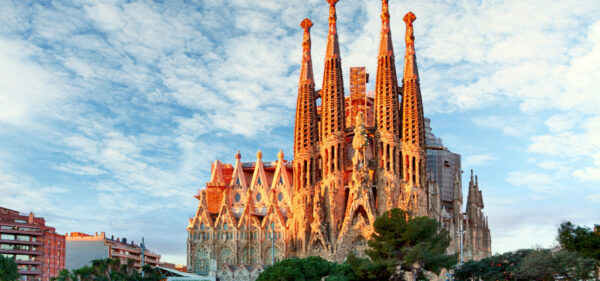
Barcelona, a city known for its vibrant culture and stunning architecture, is home to one of the most iconic landmarks in the world: the Sagrada Familia. This breathtaking basilica, designed by the visionary architect Antoni Gaudí, captivates visitors with its intricate details and towering spires, making it a must-see for anyone traveling to the city.
Experiencing the grandeur of this masterpiece is nothing short of magical. As you step inside, the light filtering through the stained glass creates a kaleidoscope of colors, enhancing the spiritual atmosphere. Indeed, **The Majestic Sagrada Familia: An Unforgettable Experience in Barcelona** awaits those who seek to immerse themselves in art and history like no other.
The Architectural Marvel of the Sagrada Familia: A Deep Dive into Gaudí's Vision
The Sagrada Familia stands as a testament to Antoni Gaudí's extraordinary vision, blending nature and architecture in stunning harmony. His **unique approach** incorporates organic shapes and forms inspired by the natural world, allowing the basilica to evoke a sense of life and movement. This integration of architecture and nature not only showcases Gaudí's genius but also creates an atmosphere that feels both sacred and alive.
One of the most remarkable aspects of the Sagrada Familia is its intricate façades, each telling a different story. The Nativity Façade celebrates the birth of Jesus with detailed sculptures and vibrant symbolism, while the Passion Façade reflects themes of suffering and sacrifice. Visitors can appreciate Gaudí's meticulous attention to detail through elements such as:
- Symbolic sculptures representing biblical figures
- Naturalistic motifs inspired by flora and fauna
- Innovative use of light and shadow to enhance spiritual experience
Moreover, the interior of the basilica is designed to mimic a forest, with columns resembling trees that stretch towards the heavens. This architectural choice not only supports the structure but also creates an awe-inspiring visual effect, making visitors feel as if they are walking through a cathedral of nature. The play of light through the stained glass enhances this experience, providing a profound sense of peace and wonder.
As the construction of the Sagrada Familia continues, it remains a **work in progress**, embodying the idea that art is an ongoing journey. Gaudí envisioned a basilica that would evolve over time, incorporating new techniques and materials. This dynamic aspect invites visitors to witness history in the making, further enriching their experience and connection to this architectural marvel.
Discovering the Spiritual Significance of the Sagrada Familia in Barcelona
The spiritual significance of the Sagrada Familia extends beyond its architectural beauty, inviting visitors to embark on a profound journey of faith and reflection. As an emblem of Christianity, this basilica serves as a place of worship where the sacred and the artistic intertwine, creating an atmosphere rich in spiritual meaning. Each detail, from the towering spires to the intricate sculptures, is infused with symbolism that resonates deeply with the beliefs of many.
Visitors often find themselves captivated by the basilica's ability to evoke awe and reverence. The carefully crafted iconography, which depicts scenes from the Bible, encourages contemplation and spiritual connection. Key elements that enhance this experience include:
- The Twelve Apostles adorning the Nativity Façade
- Scenes of the Passion on the Passion Façade
- Stained glass windows that tell biblical stories through vivid colors
The interior space of the Sagrada Familia further amplifies its spiritual presence. By mimicking the natural world, the basilica creates a serene environment that invites meditation and prayer. The interplay of light and shadow, combined with the sounds of nature, fosters a deep sense of peace, allowing visitors to reflect on their own spiritual journeys within its hallowed walls.
Ultimately, the Sagrada Familia is not merely an architectural wonder; it is a living testament to faith, creativity, and humanity's quest for deeper meaning. As visitors explore this remarkable basilica, they are reminded of the connection between art and spirituality, revealing how such experiences can enhance our understanding of the divine.
Visiting the Sagrada Familia: Tips for an Unforgettable Experience
To make the most of your visit to the Sagrada Familia, it's essential to plan ahead. Booking your tickets online in advance can save you considerable time and prevent long queues. Moreover, consider visiting during the early hours or late afternoons for a quieter experience. Be sure to check for guided tour options that provide valuable insights into Gaudí's architectural genius.
When exploring the basilica, take your time to appreciate the intricate details and unique features. Don't miss out on:
- The stunning Nativity Façade, which captures the joy of Christ's birth
- The impressive interior, designed to resemble a forest, enhancing the spiritual ambiance
- The panoramic views from the towers, offering a breathtaking perspective of Barcelona
For an unforgettable experience, remember to bring a camera to capture the beauty of the Sagrada Familia. However, be respectful of the sacred atmosphere and avoid using flash photography. A guided audio tour can also enrich your visit, offering deeper insights into the basilica's symbolism and Gaudí's vision, making your journey through this architectural masterpiece even more memorable.
Lastly, consider extending your visit to the surrounding area. The Eixample neighborhood boasts charming streets filled with shops, cafes, and other architectural wonders. Take a leisurely stroll to fully immerse yourself in the vibrant culture of Barcelona, turning your visit to the Sagrada Familia into a complete and unforgettable experience.
The History Behind the Sagrada Familia: From Concept to Construction
The Sagrada Familia was conceived in 1882 by architect Francisco de Paula del Villar, but it was Antoni Gaudí who took over the project in 1883. His innovative vision transformed the basilica into a unique architectural masterpiece, blending Gothic and Art Nouveau styles. Gaudí dedicated the last 15 years of his life entirely to this project, believing that it would not merely be a building but a profound expression of faith and devotion.
The construction of the Sagrada Familia has spanned over a century, with various phases reflecting the evolving technological and artistic capabilities of the time. Key milestones include:
- The completion of the Nativity Façade in 1935
- The dedication of the crypt as a place of worship in 2010
- Ongoing work on the towers, expected to finish by 2026, marking Gaudí's centenary
Despite Gaudí's untimely death in 1926, his detailed models and plans have guided subsequent architects and craftsmen. The Sagrada Familia embodies a commitment to craftsmanship, with many artisans contributing their skills to maintain Gaudí's original vision. This ongoing dedication showcases the basilica not only as a work of art but also as a testament to human perseverance and creativity.
As construction continues, the Sagrada Familia remains a living project, integrating modern techniques while respecting Gaudí's legacy. Each stone laid is a reminder of the collaborative spirit that has brought this architectural dream closer to fruition, inviting visitors to witness the unfolding story of a masterpiece that is destined to inspire generations to come.
Exploring the Unique Features of the Sagrada Familia: A Journey Through Art and Faith
The Sagrada Familia is a remarkable fusion of artistic expression and faith, characterized by its distinctive features that reflect Gaudí's deep reverence for nature and spirituality. One of the basilica's most unique elements is its geometric design, which incorporates hyperboloids, paraboloids, and helicoids to create a dynamic architectural form. These shapes not only contribute to the building's aesthetic appeal but also enhance its structural integrity, allowing the edifice to rise majestically against the Barcelona skyline.
Another profound aspect of the Sagrada Familia is its intricate symbolism, which is woven throughout the structure. The basilica is designed to narrate the life of Christ, with each façade and interior feature serving a purpose. For instance, the Passion Façade starkly contrasts with the Nativity Façade, using angular, severe lines to convey themes of suffering and redemption. This duality invites visitors to reflect on the spiritual journey inherent in the Christian faith, encouraging a deeper connection with the message of love and sacrifice.
Moreover, the Sagrada Familia's stunning stained glass windows play a vital role in creating an ethereal atmosphere within the basilica. Each window is meticulously crafted to depict various scenes and stories from the Bible, filling the interior with a vibrant spectrum of light. The harmonious interplay of colors throughout the day subtly changes the ambiance, further enhancing the spiritual experience for visitors as they engage with the sacred space.
As you explore the Sagrada Familia, take time to appreciate the collaborative spirit that continues to shape this monumental work. The ongoing construction reflects a dedication to preserving Gaudí's vision while embracing modern techniques, allowing each generation to contribute to its legacy. This journey through art and faith not only showcases the brilliance of Gaudí but also emphasizes the basilica's role as a living testament to creativity and devotion, inviting all who enter to contemplate their own spiritual journey.
Sagrada Familia: How to Make the Most of Your Visit to Barcelona's Iconic Basilica
To truly appreciate the Sagrada Familia, consider taking a guided tour. Knowledgeable guides can provide insights into the basilica's intricate symbolism and Gaudí's architectural techniques, enriching your understanding of this monumental work. Tours often include special access to areas that are otherwise less explored, giving you a unique perspective on the ongoing construction and the artistic vision behind each detail.
Timing your visit is crucial for an optimal experience. Aim for early morning or late afternoon visits to avoid the peak crowds. This way, you can fully immerse yourself in the atmosphere of the basilica without the distraction of large groups. Additionally, check the schedule for special events or religious services, which can add a meaningful dimension to your visit.
While you're there, don't forget to explore the surrounding area. The neighborhood around the Sagrada Familia is rich with cultural attractions. Consider visiting nearby parks like the Parc de la Ciutadella or the bustling streets of Eixample, where you can enjoy local cuisine and shop for unique souvenirs. This will enhance your overall experience in Barcelona and allow you to appreciate the vibrant culture that surrounds this iconic landmark.
Finally, be sure to partake in the local culinary scene during your visit. Indulging in traditional Catalan dishes will not only satisfy your appetite but also provide a fuller experience of Barcelona's rich heritage. Here are some must-try dishes:
- Paella - A classic rice dish, often featuring seafood.
- Tapas - Small plates perfect for sharing, showcasing local flavors.
- Cream Catalana - A delightful dessert similar to crème brûlée.
 The Mystery Unveiled: Why Does La Sagrada Familia in Barcelona Take So Long?
The Mystery Unveiled: Why Does La Sagrada Familia in Barcelona Take So Long? All You Need to Know About Official Sagrada Familia Barcelona Tickets
All You Need to Know About Official Sagrada Familia Barcelona Tickets The Fascinating Saga of Sagrada Familia: Barcelona's Timeless Construction Journey
The Fascinating Saga of Sagrada Familia: Barcelona's Timeless Construction JourneyIf you want to know other articles similar to The Majestic Sagrada Familia: An Unforgettable Experience in Barcelona you can visit the category WHERE YOU CAN GO.
Leave a Reply










Read more!